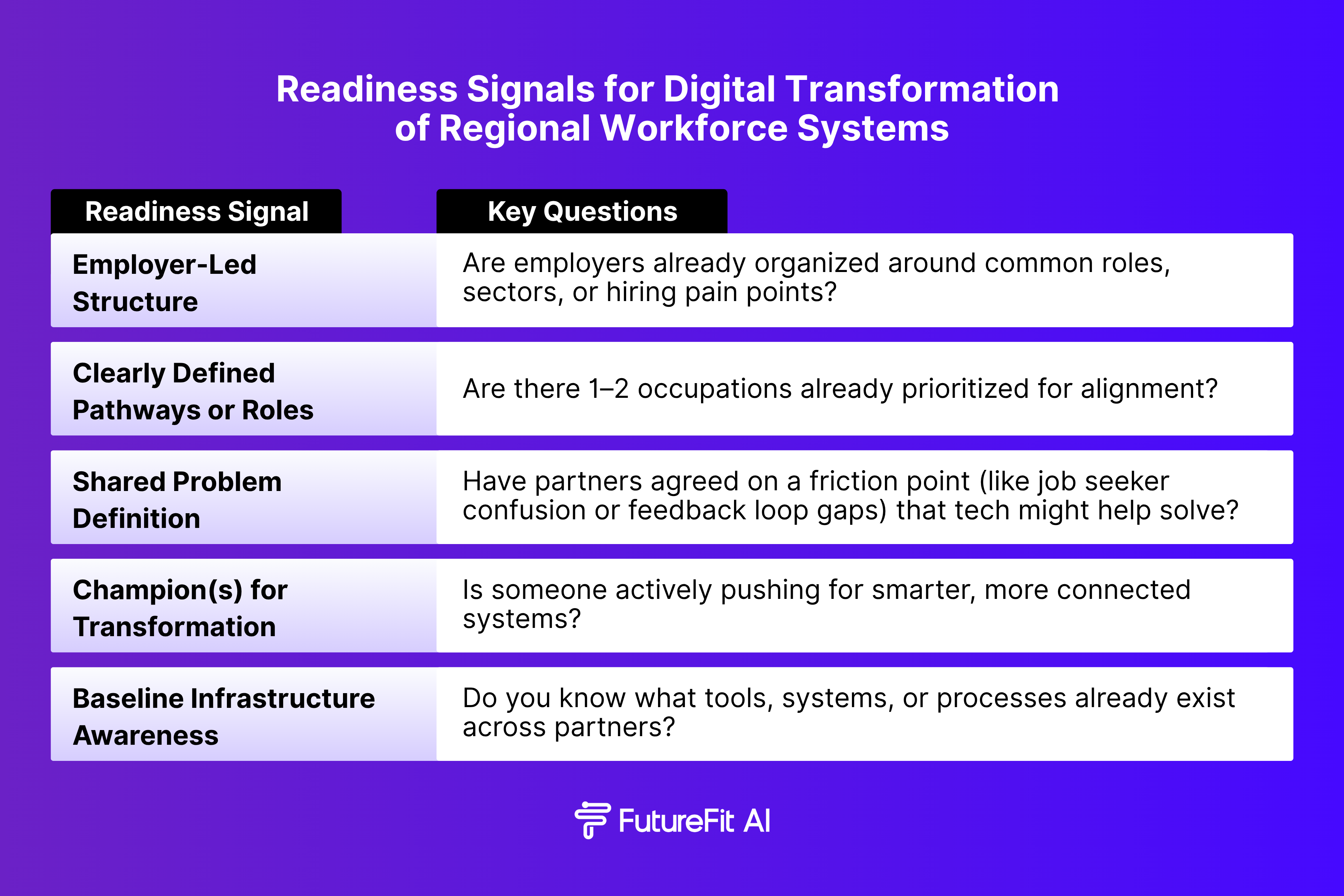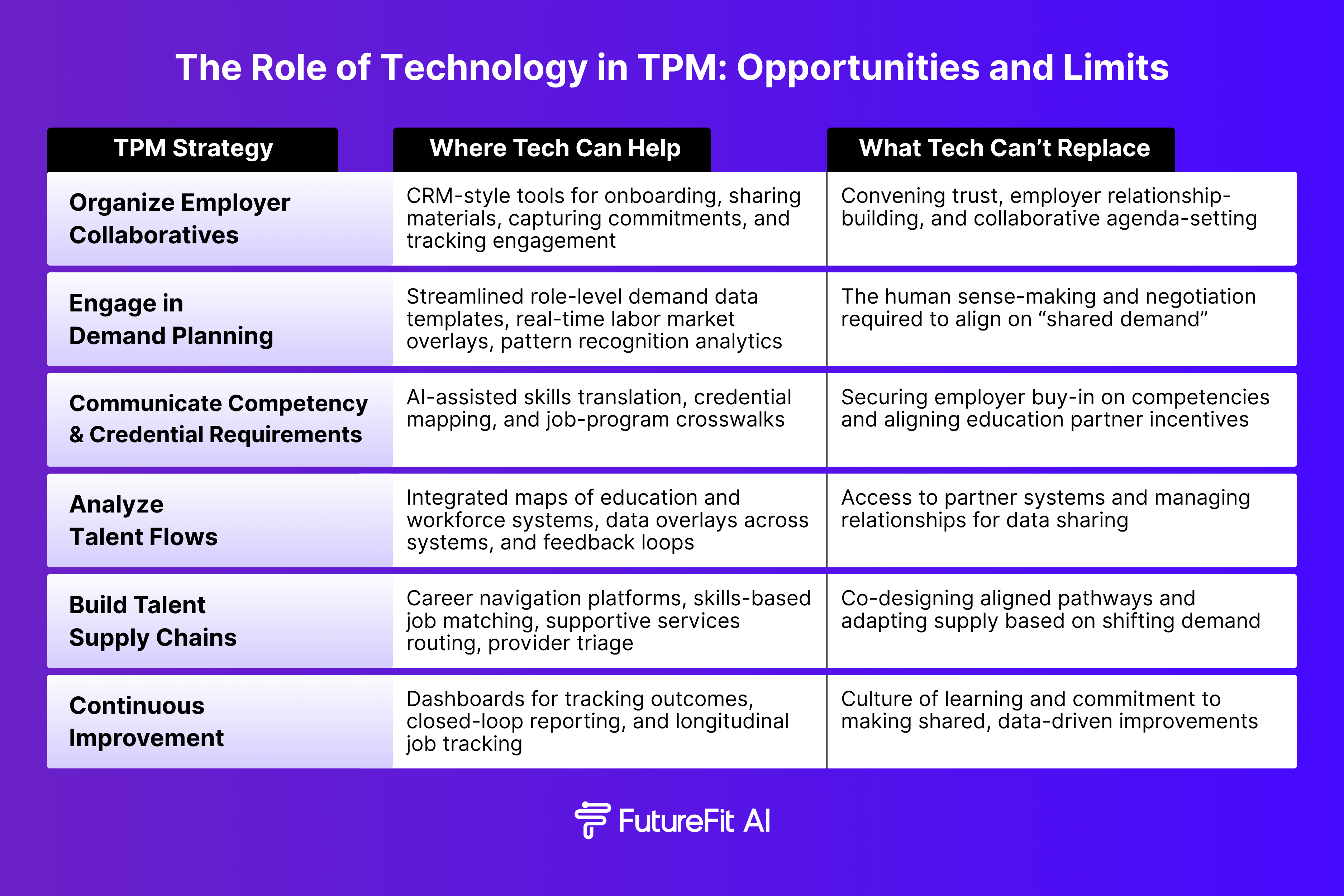products
Solutions
Resources

.jpg)
As workforce challenges become more urgent and complex, leaders across the Talent Pipeline Management (TPM) network are exploring opportunities to capitalize on past success by delivering outcomes faster, at greater scale, and with more efficiency.
At the recent TPM National Learning Network Summit, hosted by the U.S. Chamber of Commerce Foundation, this tension surfaced repeatedly:
How can workforce and education intermediaries maintain the human-centered relationships that TPM was built on—while also adapting to a world where jobseekers expect intuitive digital experiences, employers demand measurable ROI, and funding partners want real-time data?
In our conversations with TPM leaders across the country, one thing is clear: Digital transformation isn’t about modernization for modernization’s sake—it’s about solving real problems with purpose-built solutions. And when done right, it enables TPM practitioners to do what they do best: convene employers, align ecosystems, and deliver better outcomes for learners, workers, and businesses.
This post explores where technology can (and can’t) help across the TPM framework, what signs of digital readiness to look for, and how TPM leaders can begin the transformation journey without losing sight of the human relationships at the heart of this work.
Digital transformation in the TPM context isn’t just about adopting new tools. It’s about fundamentally rethinking how work gets done, and how technology can support (not replace) the human efforts that make employer collaboratives effective.
It’s the difference between:
At its best, digital transformation helps TPM practitioners spend less time gathering information and more time acting on it—aligning faster, learning in real-time, and adapting with confidence.
Many leaders ask: “Are we ready for digital transformation?” The answer is often: more than you think.
Based on our work with dozens of workforce organizations and regional partnerships, here are a few signals of readiness — and some questions to help you surface your biggest friction points (where tech can often help most):

And on the other side, here are five friction points where partners consistently see the biggest lift from technology:
You don’t need to have all of these figured out. You just need a clear pain point — and the willingness to tackle it in partnership.
The TPM framework outlines six key strategies. Technology can play a supportive role in nearly all of them, but it’s not a silver bullet. We've seen firsthand that the most successful TPM-aligned organizations know how to use tech to amplify what humans do best: build trust, align vision, and drive collaborative change.
Here’s a practical breakdown of where technology can support TPM work — and what still depends on people, partnerships, and shared context:

The U.S. Chamber of Commerce Foundation’s TPM framework has offered workforce leaders a durable, structured approach for employer engagement and system alignment. As the network continues to evolve, technology can help make those systems more connected, scalable, and sustainable.
Digital transformation isn’t about changing what TPM leaders do. It’s about reinforcing it. It’s about helping you move from pilot to platform, from programs to outcomes, from coordination to infrastructure.
At FutureFit AI, we’re proud to support TPM-aligned leaders across the country as they explore what digital transformation looks like for their ecosystems. Whether it’s streamlining employer onboarding, connecting feedback loops, or designing tech-powered career pathways, our goal is simple: to extend your impact, not replace it.
If you’re part of the TPM network and exploring digital transformation in your region, we’d love to connect. Get in touch with us here!
FutureFit AI partners with regional coalitions to design, build, and scale tech infrastructure for workforce ecosystems. Learn more at futurefit.ai.
.png)
.jpg)
As workforce challenges become more urgent and complex, leaders across the Talent Pipeline Management (TPM) network are exploring opportunities to capitalize on past success by delivering outcomes faster, at greater scale, and with more efficiency.
At the recent TPM National Learning Network Summit, hosted by the U.S. Chamber of Commerce Foundation, this tension surfaced repeatedly:
How can workforce and education intermediaries maintain the human-centered relationships that TPM was built on—while also adapting to a world where jobseekers expect intuitive digital experiences, employers demand measurable ROI, and funding partners want real-time data?
In our conversations with TPM leaders across the country, one thing is clear: Digital transformation isn’t about modernization for modernization’s sake—it’s about solving real problems with purpose-built solutions. And when done right, it enables TPM practitioners to do what they do best: convene employers, align ecosystems, and deliver better outcomes for learners, workers, and businesses.
This post explores where technology can (and can’t) help across the TPM framework, what signs of digital readiness to look for, and how TPM leaders can begin the transformation journey without losing sight of the human relationships at the heart of this work.
Digital transformation in the TPM context isn’t just about adopting new tools. It’s about fundamentally rethinking how work gets done, and how technology can support (not replace) the human efforts that make employer collaboratives effective.
It’s the difference between:
At its best, digital transformation helps TPM practitioners spend less time gathering information and more time acting on it—aligning faster, learning in real-time, and adapting with confidence.
Many leaders ask: “Are we ready for digital transformation?” The answer is often: more than you think.
Based on our work with dozens of workforce organizations and regional partnerships, here are a few signals of readiness — and some questions to help you surface your biggest friction points (where tech can often help most):

And on the other side, here are five friction points where partners consistently see the biggest lift from technology:
You don’t need to have all of these figured out. You just need a clear pain point — and the willingness to tackle it in partnership.
The TPM framework outlines six key strategies. Technology can play a supportive role in nearly all of them, but it’s not a silver bullet. We've seen firsthand that the most successful TPM-aligned organizations know how to use tech to amplify what humans do best: build trust, align vision, and drive collaborative change.
Here’s a practical breakdown of where technology can support TPM work — and what still depends on people, partnerships, and shared context:

The U.S. Chamber of Commerce Foundation’s TPM framework has offered workforce leaders a durable, structured approach for employer engagement and system alignment. As the network continues to evolve, technology can help make those systems more connected, scalable, and sustainable.
Digital transformation isn’t about changing what TPM leaders do. It’s about reinforcing it. It’s about helping you move from pilot to platform, from programs to outcomes, from coordination to infrastructure.
At FutureFit AI, we’re proud to support TPM-aligned leaders across the country as they explore what digital transformation looks like for their ecosystems. Whether it’s streamlining employer onboarding, connecting feedback loops, or designing tech-powered career pathways, our goal is simple: to extend your impact, not replace it.
If you’re part of the TPM network and exploring digital transformation in your region, we’d love to connect. Get in touch with us here!
FutureFit AI partners with regional coalitions to design, build, and scale tech infrastructure for workforce ecosystems. Learn more at futurefit.ai.
.png)